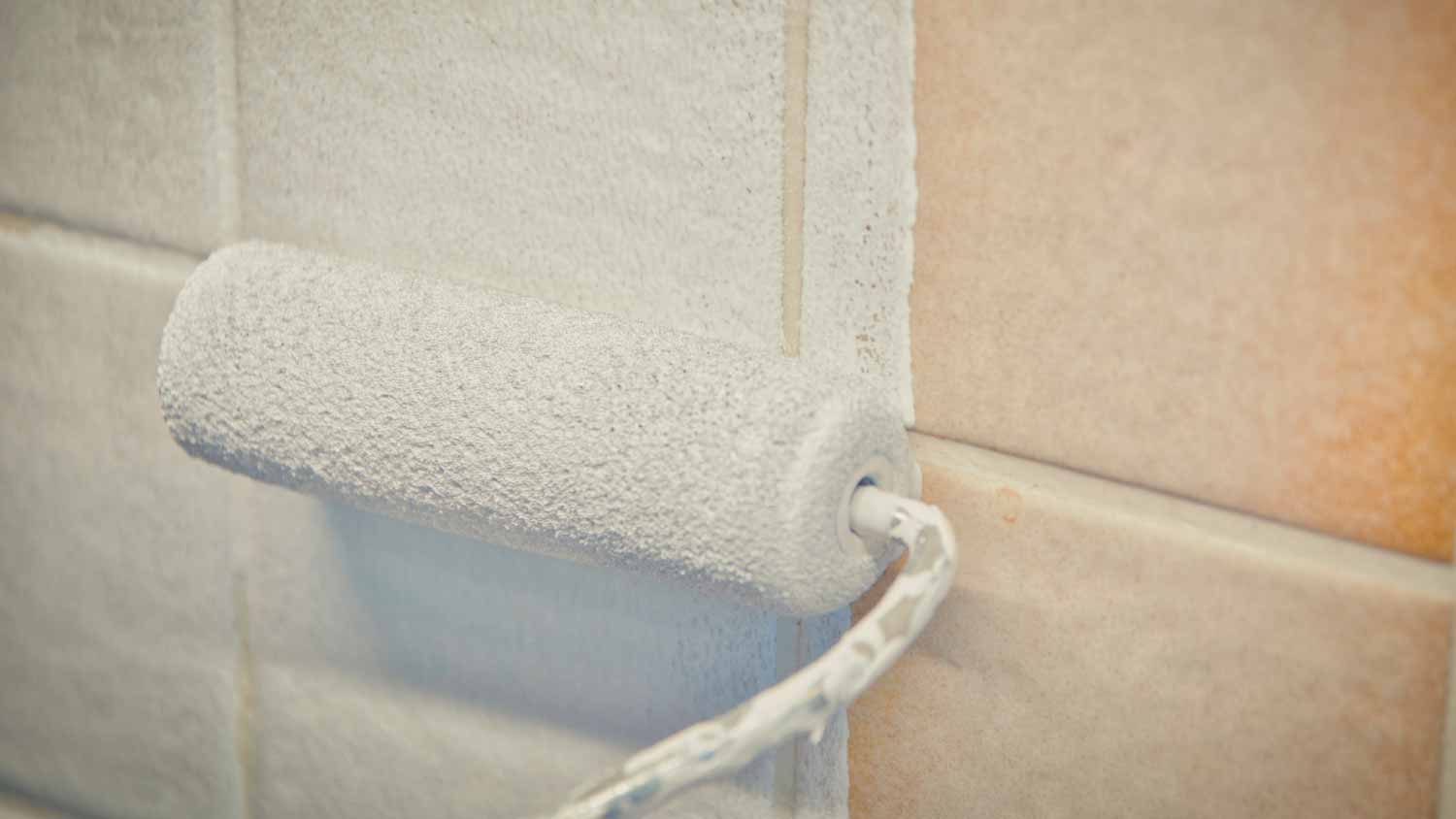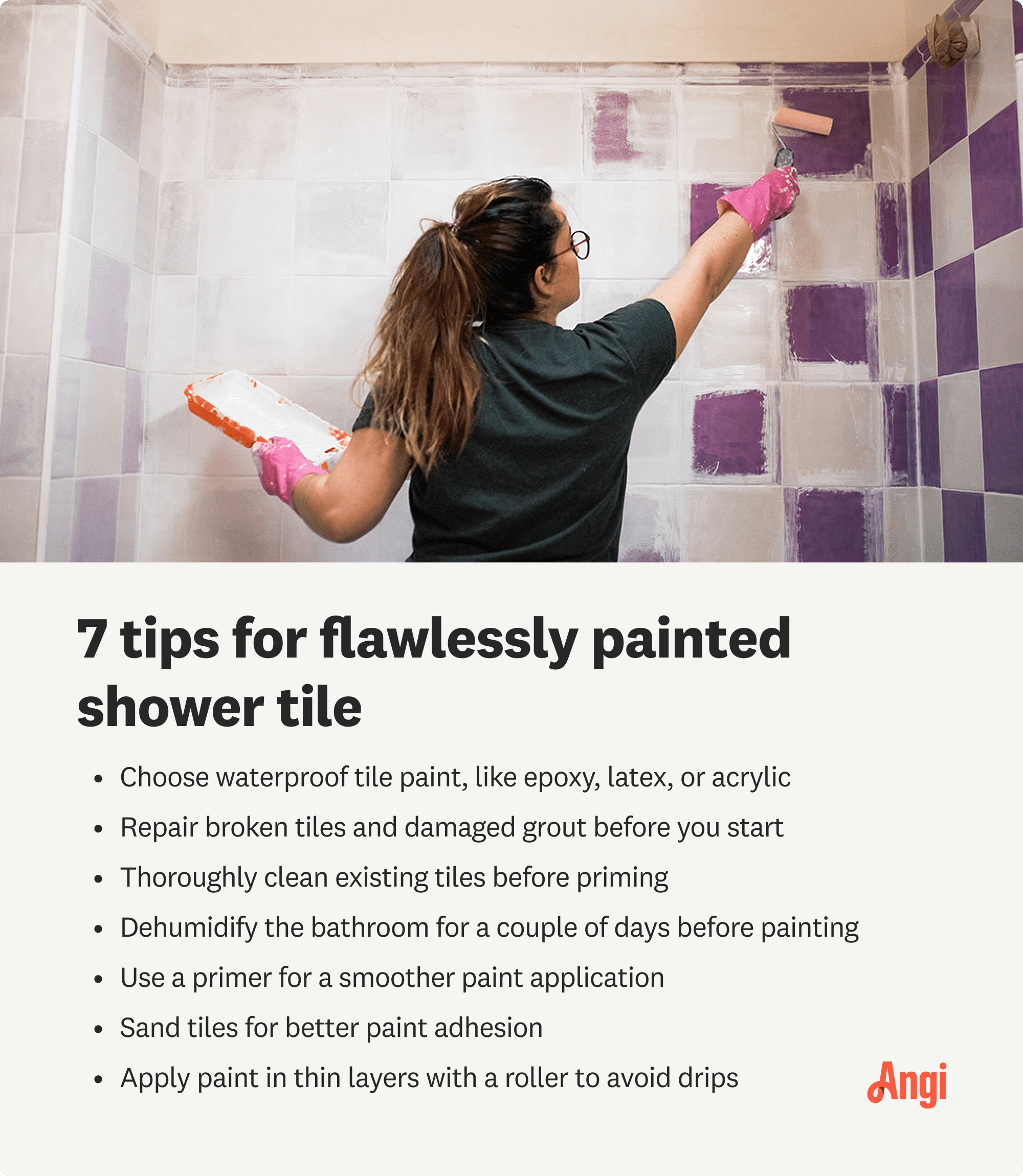
The cost to install porcelain tile depends on materials, size, and whether you DIY or hire a pro. This guide will help you choose the perfect porcelain tile for your home and budget.
Get a custom (if temporary) tile look for less


Shower tile paint is a temporary option to refresh tile and lasts one to five years.
Painting shower tile costs $50 to $100 on average.
By comparison, retiling a shower costs $1,800 to $5,000.
Painting a shower may take a weekend up to a full week with drying times.
Imagine you step into the shower after a long day, but rather than letting the steam relax you, all you can do is stare at the outdated tiles surrounding you. You’re not sure that you’re ready to tear out the tile and start fresh, so you might be wondering, “Can you paint shower tile?” Though the short answer is “yes,” there are several factors to consider, like cleaning and longevity, before you take on this project.
Technically, yes, you can paint shower tile, but how well the final project looks depends on the type of tile you have and the paint you choose. You can paint most tiles, including ceramic, porcelain, and natural stone tiles, with no issues, but it can be difficult to paint on glazed quarry tiles because the paint won’t stick to the slick, glazed surface.
As for choosing paint, stick to paints that are specifically designed for moisture-resistance and tile for the best chance of the paint sticking to the tile.

The biggest reason people consider painting shower tile is that they’re tired of the look of the existing tile but don’t have the budget for retiling. Tiling a shower costs $1,800 to $5,000. In comparison, painting shower tile costs $50 to $100 for all the supplies you’d need, including paint, primer, caulk, and paint brushes and rollers.
Consider acrylic instead of tile for your next bathroom project. Acrylic is less expensive, easier to maintain, more durable, and less time-consuming to install.
Painting shower tile is also considered more DIY-friendly than tearing out the existing tile and replacing it with fresh, thin-set mortar, tile, and grout. You can paint tile yourself as a weekend project.
For artistic homeowners, painting shower tile also offers a chance to completely customize the look of your shower. You can paint all the tile in a fresh coat of plain white paint for a bright, serene feel, or get creative with a variety of colors and patterns painted by hand.

With major cost savings and a chance to create the shower tile design of your dreams, there are several benefits to painting shower tile. However, this project also comes with drawbacks to consider.
First and foremost, shower tile paint won’t last forever. Because the paint is applied in a high-moisture area, it’s guaranteed to bubble, fade, and flake over time. Even if you pick waterproof paint, constant water exposure and scrubbing while cleaning the shower will eventually wear down the paint.
Paints strong enough to stand up to moisture often come with a strong chemical smell, so keep in mind that you may be stuck with these odors for several days or a couple of weeks.
Although painting shower tile is an easier project for homeowners than retiling the shower, it’s not that much quicker. First, you’ll need to add a dehumidifier to the bathroom for a day or two before painting to make sure the air is dry enough for the paint to stick to the tile. Then, you’ll need to prep the tile by cleaning and sanding it. Finally, you can apply primer, let it dry, add the paint, and let the paint dry and cure. It may take a weekend or two to fully tackle this project.
While shower tile paint won’t last as long as new tile, there are some steps you can take to extend the life span of the paint.
Run a dehumidifier and avoid using the shower for at least a day or two prior to priming and painting.
Repair any damaged tiles or grout before starting the painting process. If you’re not skilled in tile repair, hire a tile repair pro near you for help.
Clean the existing tiles and shower and tub surfaces as thoroughly as possible.
Remove old caulking.
Sand down the existing surfaces.
Apply primer and let it dry fully before adding paint.
Give the paint at least two days and up to one week to fully dry and harden before using the shower.
Use gentle, non-abrasive cleaners, like warm water and a mild soap, to clean tiles.
From average costs to expert advice, get all the answers you need to get your job done.

The cost to install porcelain tile depends on materials, size, and whether you DIY or hire a pro. This guide will help you choose the perfect porcelain tile for your home and budget.
.jpg?impolicy=leadImage)
Sealing your grout goes a long way toward extending its life span. This guide breaks down the cost factors for sealing grout, including size, materials, and labor.

The cost to install travertine tile depends on materials and the size of the project. This guide to travertine tile cost will help you budget accordingly.

With so many different types of caulk on the market, how do you know which one is right for your home improvement project? Here’s how to figure it out.

What causes tile to crack? We discuss seven reasons why your tile floors are cracking, including falling objects and installation problems, and how to stop it.

Discover the key differences between acrylic versus silicone caulk to choose the right sealant for your next DIY project.